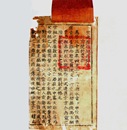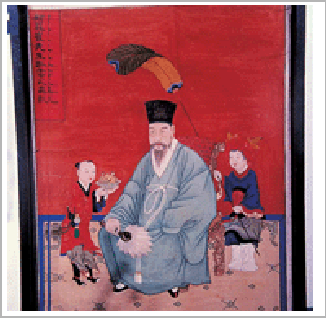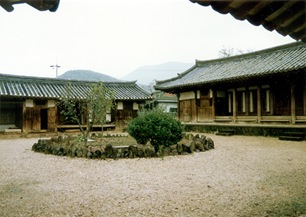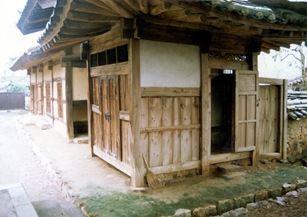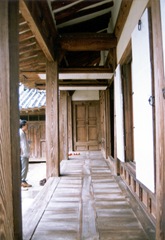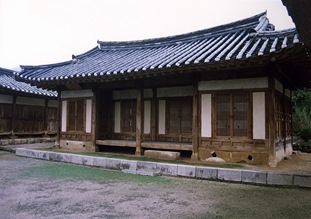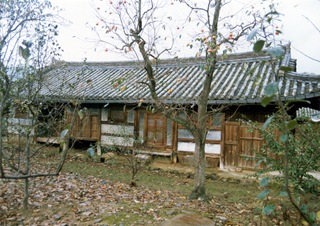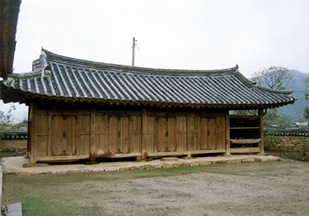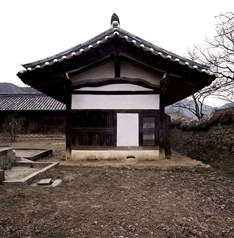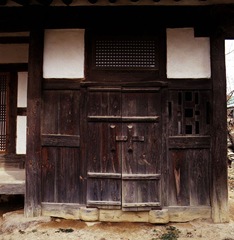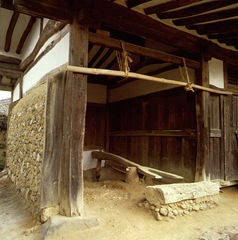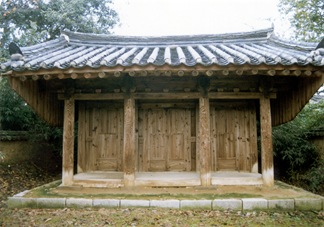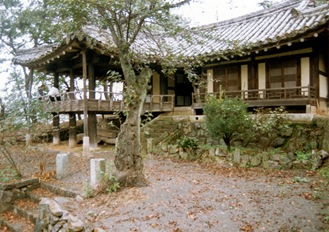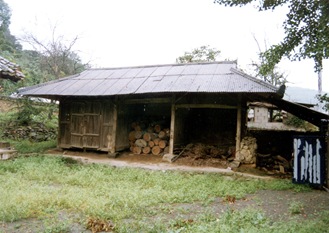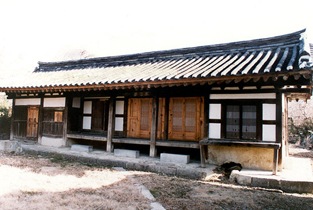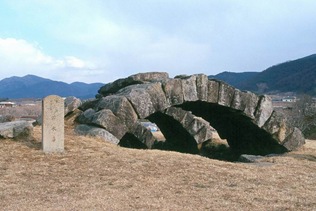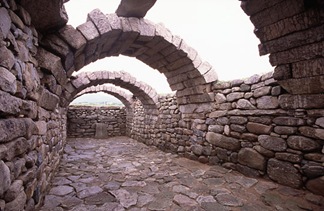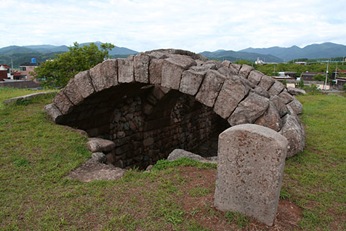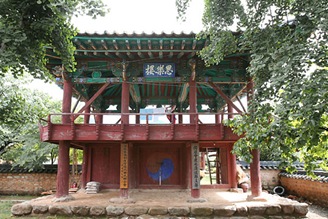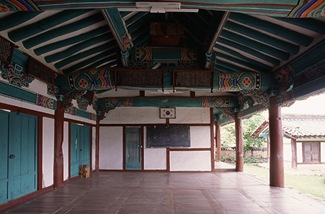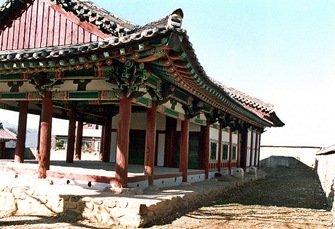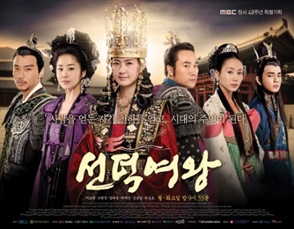
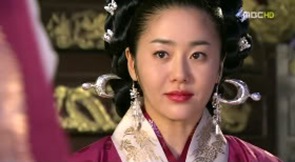
I love the costumes, the dances and the Hwarang displays. Everything is just exquisite. What I really enjoy, is the part of Mishil, played by Go Hyun-jung. A leader of the Hwarang (Shilla’s youth corps), Mishil’s official title is Seju, bestowed by the king on royal concubines. Mishil is an attractive and powerful woman, who will let nothing stand in the way of her ambition to become queen. At times she can be seductive and sometimes even scary, which is very well portrayed by the actress. It’s just fantastic that this woman had a husband who could share her with so many other men. Sometimes I get confused as to who's the father of which particular son. The storyline is very well written which makes this drama very interesting. At least now I know something about the great General Kim Yushin whom I’ve come across in the course of my research for my blog posts.
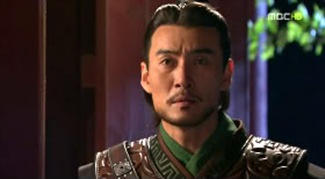
I also like the Chief Marshal of the Hwarang, Munno, who together with General Yushin were the only men who were not under Mishil’s spell and who openly opposed her.

Not to be outdone is the part of the young Seondeok (played by Nam Ji-hyun) the time she was in the desert.
If not for my eyes beginning to feel a bit tired, I’m sure I won’t be writing this today. So I’ve decided to publish my post and get some sleep before I continue with my Queen Seondeok drama.
Today I’m going to tell you about the special products of Cheongdo first before we do any sightseeing. Top of the list is of course, the Cheongdo Bansi persimmon that only grows in Cheongdo. Cheongdo’s seedless and sweet Bansi persimmon is good for health with its valuable nutritional contents.
The persimmons are sliced and then dried in the sun to make a sweet snack which is loved by people of all ages. It is supposed to be good for preventing colds and skins from aging.
Ice-cold persimmons also make a good alternative for ice-cream as a dessert.
The traditional wine 'Gamgrin' is made from persimmons. As a white wine, it has plenty of tannin, giving it an astringent taste. It was officially selected as a dinner wine in the Busan APEC, 2005.
Kosher vinegar is made with sweet, ripe Cheongdo persimmons, naturally fermented and ripened.
Persimmons are also made into a type of Korean snack that’s made with glutinous rice and persimmons.
Not only is the fruit eaten, the leaves are used to make Persimmon Leaf Tea. The vitamins in Persimmon Leaf Tea strengthen the immune system and this tea also contributes to efficient blood circulation to prevent high blood pressure, hardening of the arteries, dementia or stroke.
Persimmon and Grain Powder Food is a well-balanced nutritional food in which 10 types of grains and the Cheongdo seedless persimmon are mixed. It is good as an alternative meal for busy commuters in the morning or for patients.
The white peach is famous for its fragrance and sweet and juicy taste. It helps to stimulate appetite and to overcome fatigue while its aspartic acid helps to relieve hangovers. Its affluent vitamin A and C, and fiber are effective for the prevention of constipation and a good diuretic effect.
The pear, an alkali rich fruit is best cultivated in areas with a clear difference in temperature between day and night. It has a plenty of vitamins to speed up the metabolism.
Cheongdo apples grow in areas with excellent natural conditions with a clear difference in temperature between day and night, and clean air and water. They are very sweet and crispy and of excellent quality.
The Papaya has an excellent fragrance and plenty of Calcium, Iron, minerals, Saponin, Vitamin C, and Tannin and it can be eaten or used as an ingredient in oriental medicine.
The Cheongdo jujube is large and uniform. It is bright red in color and has a high degree of sweetness. It is well-dried and sweet with its uniquely good fragrance.
The Strawberry has a vivid color and sweet taste with a good fragrance and is of excellent quality. In addition, it is rich in vitamin C which is good for health.
Vegetables come second after the fruits.
The patented Semical dropwort is regularly sprayed with high quality selenium, mineral and calcium in the Hanjae district. This excellent dropwort has a thick but soft stem with a high degree of sweetness.
The Hanjae Hwayaksan dropwort is cultivated with base rock groundwater on the hillside of Hwyaksan(Mt.). It has a thick but soft stem with a good fragrance. It is the best dropwort in the nation. If you eat it for a long time, it will give you energy and detoxify your body.
Neither chemicals nor fertilizers are used to farm the Selenium-Function tomatoes. Only selenium natural herb juice and herb liquid are sprayed to produce Selenium-Function Tomato with excellent taste and fragrance.
Paprika, which originated in Central Asia, has a unique taste and fragrance with a high degree of sweetness 7~8 degree higher than that of a regular tomato. Red, yellow or orange paprika contains 19 trace elements that make it good as a nutritional snack for children, or a beauty food for women, and it also serves as a decoration for various foods.
Cheongdo-gun has fertile land and a clear difference in temperature between day and night to raise plain tasting unripe pepper with plenty of minerals and excellent fragrance.
Punggak Pepper has thick skin and less seeds and it provides hot and sweet tastes at the same time. Many merchants come here from all over Korea to buy Punggak Peppers during the Punggak Five-Day Pepper Market.
Top Mushroom is cultivated with Cheongdo’s clean air and underground water. It is fresh and good at preservation. It has earned non-chemical quality certification. It helps anti-germ and adjustment of blood pressure since it has a plenty of amino acid and vitamins.
Shiitake Mushroom grows on oak trees in Unmun Dam’s clean water and fresh air. It has thick fleshiness and excellent fragrance while it is effective for anti-cancer and prevention of adult diseases.
Oyster mushrooms, fresh and good at preservation since it is cultivated at clean areas; the Oyster mushroom has sweet fleshiness and a delicious taste while it is effective for anti-cancer and immunology.
Mainly turbo onions are cultivated to create excellent taste and fragrance and good at preservation. Cheongdo onion is sweet and hard and excellent at preservation as well as effective for prevention of adult diseases.
Stubborn Bull’s Rice, strictly selected high quality rice from Cheongdo, a village of Bull Fighting. Premium brand that produces only high quality rice to upgrade rice taste.
Unmunsan Malgeun Sam is cultivated using rice bran agricultural technology in Unmunsan(Mt.)’s clean water and beautiful natural environment. It is a high quality and eco-friendly rice
Well-being Cheongdo Rice grown in Cheongdo with good mountains and clean water is processed under a strict quality control system.
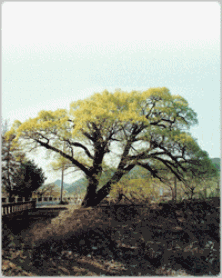
The Willow in Gakbuk-myeon, Natural Monument #298, is called Teolwangbeodeul because, compared to a normal willow, it is tall and its leaves are wide and the tips of the leaves and branches are covered with fur. It is used as a windbreaker. It is also used as an arbor tree.
The Teolwangbeodeul is about 200 years old. It is 15m high and 4.9m wide. It is located along the stream beside the Deoksan Elementary School. Villagers use it as a resting place.
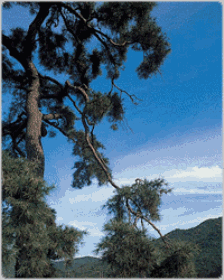
The Weeping red pine in Maejeon-myeon, Cheongdo, has been designated Natural Monument #295. Because the branches grow downward naturally like a willow, this tree is called Yusong. The tree has a unique appearance and is also biologically valuable. It is about 200 years old. It is 14m tall and has a girth of 1.9m. The branches droop downward and the appearance is unique and beautiful.
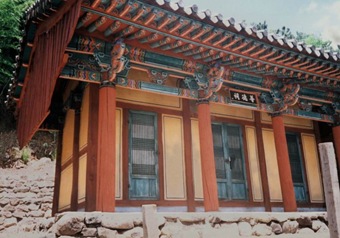
The Jagyeseowon, in Seowon-ri, Iseo-myeon Tangible Cultural Properties #83 consist of three units. The Jagye Confucian academy, originally called Ungyeseowon, was built in 1518, the 13th year of King Jungjong(1506-44)of the Joseon Kingdom(1392-1910), to honor Kim Ilson(Tagyeong, 1464-98), a scholar and government official of the early Joseon period.

It was reconstructed in 1578, the 11th year of King Seonjo(1567-1608) and received royal acknowledgement in 1661, the second year of King Hyeonjong(1659-74), when it was renamed Jagyeseowon by the court.
Kim Ilson was a section chief in the Ministry of Personnel when he was condemned to death by King Yeonsangun(1494-1506) because he had earned the king's ire with the inclusion in the royal chronicles of a writing criticizing the usurpation of the throne by King Sejo(1455-68). After King Yeonsangun was dethroned by King Jungjong, Kim was posthumously promoted to the rank of the first royal secretary.
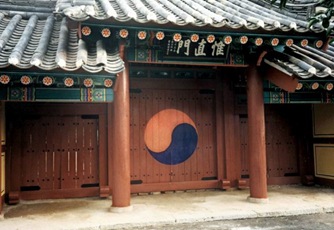
Yeonggwiru Pavilion and other buildings were added in 1699, the 25th year of King Sukjong(1674-1720), but all were destroyed in 1871, the eighth year of King Gojong(1863-1907) when private Confucian academies throughout the country were destroyed as a matter of government policy.
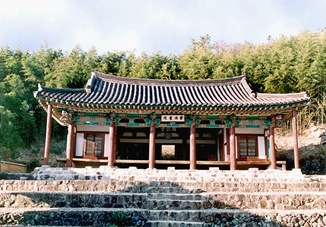
The present facilities were constructed in 1924. Memorial services are held here for Kim, his grandfather Kim Geukil and his nephew Kim Daeyu.
And now for some of the recommended famous spots of Cheongdo.
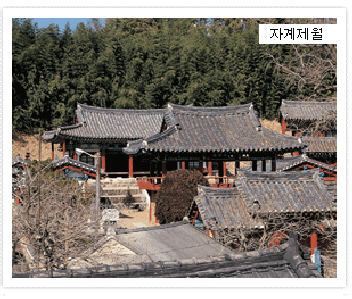 Jagyejewol refers to the stunning reflection of a full moon on the clear waters of the Cheongdocheon(Stream), which flows through Jagye Seowon in Seowon-ri, Iseo-myeon. The view is accentuated by the silent beauty of the bright moon’s reflection, and the surrounding landscape of an old scholar’s house.
Jagyejewol refers to the stunning reflection of a full moon on the clear waters of the Cheongdocheon(Stream), which flows through Jagye Seowon in Seowon-ri, Iseo-myeon. The view is accentuated by the silent beauty of the bright moon’s reflection, and the surrounding landscape of an old scholar’s house.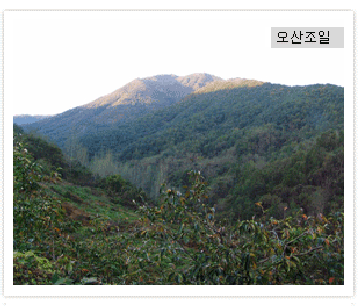 Osan is the old name for the present Namsan(Mt.). The word “Osanjoil” indicates the spectacular view of Namsan(Mt.) when the sun rises. With the Hwaaksan (Mt.) to the back and the wide open field to the front, the Namsan(Mt.) offers the best view in the early morning sunlight when the mountain peaks and valleys under the mist form a picturesque scene. Namsan is 870 meters high and is the major mountain of the Cheongdo region.
Osan is the old name for the present Namsan(Mt.). The word “Osanjoil” indicates the spectacular view of Namsan(Mt.) when the sun rises. With the Hwaaksan (Mt.) to the back and the wide open field to the front, the Namsan(Mt.) offers the best view in the early morning sunlight when the mountain peaks and valleys under the mist form a picturesque scene. Namsan is 870 meters high and is the major mountain of the Cheongdo region.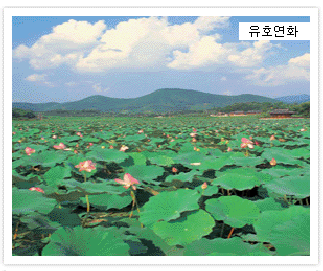
Yuhoyeonhwa is a pond located in Yudeung-ri Hwayang-eup. It is also called Silla Pond and is 700 meters in diameter and 2 meters deep. The pond is famous for its lotus flowers which were planted by Yi Yuk, the younger brother of Yi Ju who was banished to the region under the Yeonsangun’s rule during the Joseon Dynasty. In the summer, red lotus flowers with their roots make harmonious scene and people fishing in this pond lend a hand in making it more peaceful looking.
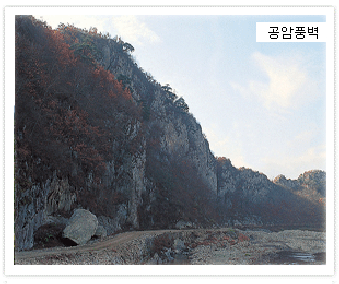
Gonampungbyeok is a half-moon cliff located in Gongam-ri Unmun-myeon, on the road from Daecheon-ri Unmun-myeon to Gyeongju-si.
The cliff is 30 meters high and offers a magnificent view in all seasons. In the spring, every kind of flower, including azalea, blooms, and in the summer, the icy clean water makes one’s heart stop with wonderment. In the fall, autumn leaves color the cliff, and in the winter, green pine trees represent the noble sprit of the county.
One can still find remnants where dragons and cranes were said to have lived between the cliffs.
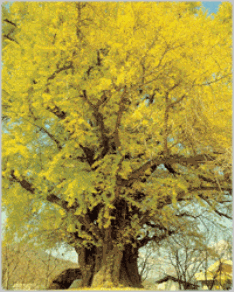
The Gingko Tree in Iseo-myeon, Cheongdo, Natural Monument #301 is assumed to be about 400 to 1,300 years old. Its height is about 29m, and its girth is about 8.5m. The branches are 27.2 meters wide to the east and west and 24 meters wide to the north and south. Legend says the tree sprouted on the site of a well where an old Buddhist monk fell and died while trying to drink.
Let us now take a look at some of the other cultural assets/properties of Cheongdo-gun.
 |  |  |
 |  |  |
The Milseongparkssi samujeongpa jongjungsojangmunjeok in Cheongdo-gun, Treasures #1237 is an entire collection of 4 kinds of ancient manuscripts consisting of 17 Items.
These documents had been given to Parkgyeongsin and his two sons, Jinam and Cheolnam, during the reign of King Seonjo.
Parkgyeongsin was a military officer in the reign of King Seonjo. He belonged to the Milyang Park's family and his pen name was Samujeong. He passed the first course of the state military examination when he was 31 years old, and won the first place in the entire course of the state military examination when he was 35 years old. Then, he was appointed the general. He escorted the King's escape during the Hideyoshi's Invasion into Korea. He mustered the volunteers and defended Cheongdo against the Japanese army.
After this war, he was appointed as 'Seonmuwonjonggongsin-ildeung(the most meritorious retainer)'. His two sons were appointed as 'Seonmuwonjonggongsin-edeung(the second rank of meritorious retainer.)

Baejayebuunnyakpanmok(Wood printing blocks for Baejayebuunnyak) in Sinji-ri, Geumcheon-myeon, Treasures #917 are wooden blocks used for printing the Baejayebuullyak, a rhyming dictionary compiled in Sung China. Introduced to Korea during the Goryeo period (918-1392), the dictionary was an essential reference book for the upper-class students preparing for the state civil service examination.
Though other rhyming dictionaries with Korean annotations such as Hongmujeongun and Donggukjeongun appeared during the Joseon period(1392-1910), it remained the most popular rhyming dictionary until the publication of the Samuntonggo with an easier index system in 1702.
It was named after the name of the ministry managing the civil service exam, Yebu.
It has 152 pages and published by Park Dongbu in the 5th year of King Sukjong (1679). It consists of 4 parts, preface, body, dictionary, and Bal, and it's 46.2cm long, 20.5cm wide and 1.8cm thick and It's the only dictionary preserved perfectly without any missing pages.
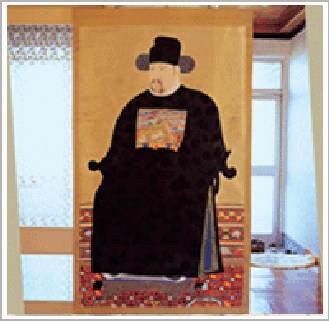
Yiullyongjanggunyeongjeong(Portrait of General Yi Unryong) Tangible Cultural Properties #89
This portrait is of Yi Unryong(1562-1610), a distinguished military officer during Joseon(1392-1910).
Yi was a lieutenant under Admiral Yi Sunsin during the Japanese Invasion of 1592-98 and later served as the deputy commander of the Five Military Commands, army commander of Hamgyeong-do, and navy commander of Chungcheong-do as well as in many other posts until his death at 49.
The portrait appears to have been painted in 1604 when Yi Unryong was honored by King Seonjo(1567-1608) with the third grade award of Seonmugongsin and given the title Sikseonggun for his outstanding service during the war with Japan.
Judging from the single tiger on his chest and the crane embroidered on the belt, status symbols of junior second grade officials, the portrait was done when Yi was the deputy commander of the Five Military Commands, which corresponds to the year he was cited.
Of a highly refined style, the portrait is typical of official portraits of meritorious officers painted during the mid-Joseon period.
Choe Chiwon also known by his pen name Goun, was a famous scholar and official of the Unified Silla period(668-935) who studied in T'ang China and served in public posts there for some time, having passed the Chiness civil services examination.
He is best known for his condemnation of the brigand leader, Huang Ch'ao, in "Manifesto Denouncing Huang Ch'ao," written in 879.
It was so eloquent and dramatic that Huang Ch'ao fell off his bed with fright when he read it.
Choe's portraits are enshrined in many places while most of them represent him as a Buddhist monk, this one portrays a literary man in the Chinese fashion.
Choe is sitting on a chair in a robe and square hat and is holding a fan.
There is a boy with a bowl of pomegranates and a girl with a palm leaf fan at his sides, which makes it a rare example of an unusual composition, as most of the portraits painted in the Joseon period(1392-1910) depict only one person without any minor figures.
The washing technique employed in depicting the face and the folds of the robe and the patterns on the mat on the floor indicate it is an imitation of the original made in the late Joseon period.
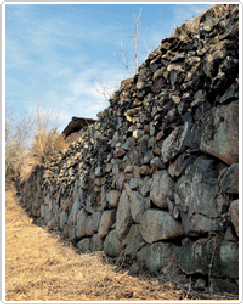
The Cheongdo town wall (Monument #103) was in existence since the Goryeo Dynasty. The wall was made with a mixture of stone and earth and surrounded Seosang-ri, Dongsang-ri and Gyochon-ri in Hwayang-eup. It was later rebuilt as a stone wall during King Sunjo’s rule during the Joseon Dynasty. Its circumference is 1.88 kilometers and the wall is 1.7 meters thick. The wall was demolished during the Japanese colonial rule and now only the remnants of parts of the wall and the foundation are left.
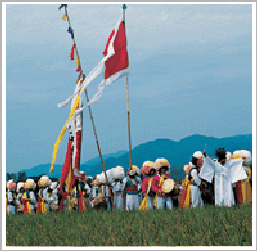
Chasan Nongak Intangible Cultural Asset #4 gained popularity with the development of a folk game called Cheonwanggil Flag Battle. It was a game enjoyed by villages such as Chasan-ri, Iseo and Changnyeong every Lunar New Year, The villages showed off their strength by organizing farmers’ percussion band and farmers’ flags. Since 1933, the band was made up of 18 people from Chasan-ri and they played a variety of music once a year on the first full moon of the Lunar New Year to pray for a good harvest and dispel evil spirits.
I’m afraid I’ve to end here as I can hardly keep my eyes open. So till my next post, goodbye for now.
Special thanks and appreciation to the following:
Photos and articles © courtesy
http://english.cheongdo.go.kr
http://jikimi.cha.go.kr/English
http://www.visitkorea.or.kr




